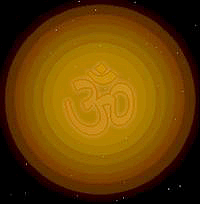

Zitierweise / cite as:
Payer, Alois <1944 - >: Dharmashastra : Einführung und Überblick. -- 10. Sakramente und Übergangsriten (samskara). -- Anhang C: Rahu und Ketu, die unsichtbaren Wandelsterne . -- Fassung vom 2004-02-18. -- URL: http://www.payer.de/dharmashastra/dharmash10c.htm -- [Stichwort].
Erstmals publiziert: 2004-02-18
Überarbeitungen:
Anlass: Lehrveranstaltung 2003/04
Unterrichtsmaterialien (gemäß § 46 (1) UrhG)
İopyright: Dieser Text steht der Allgemeinheit zur Verfügung. Eine Verwertung in Publikationen, die über übliche Zitate hinausgeht, bedarf der ausdrücklichen Genehmigung der Herausgeberin.
Dieser Teil ist ein Kapitel von:
Payer, Alois <1944 - >: Dharmashastra : Einführung und Übersicht. -- http://www.payer.de/dharmashastra/dharmash00.htm
Dieser Text ist Teil der Abteilung Sanskrit von Tüpfli's Global Village Library
Im alten Indien kennt man neun Wandelsterne (nava-graha):
Sûrya (Ravi) = Sonne
Candra (soma) = Mond
Budha = Merkur
Shukra = Venus
Mangala = Mars
Brhaspati = Jupiter
Shani = Saturn
Râhu
Ketu
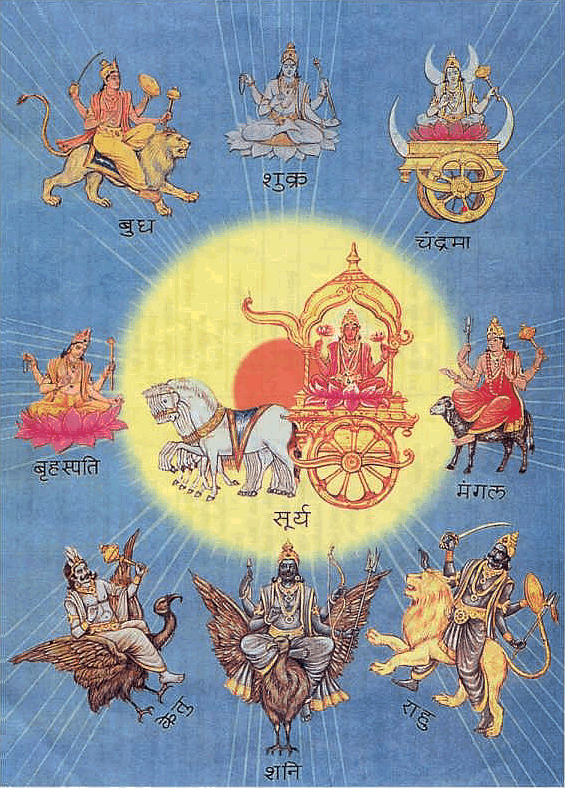
Abb.: Navagraha - die neun Wandelsterne [Bildquelle:
http://sanskrit.gde.to/doc_z_misc_navagraha/navagraha.jpg. --
Zugriff am 2004-02-07]
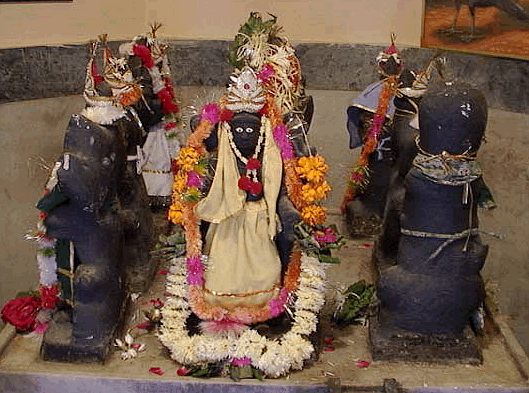
Abb.: Navagraha - die neun Wandelsterne [Bildquelle:
http://www.dattapeetham.com/india/tours/datta_kshetra_yatra/surat_leela_viswambara/surat_2002.html.
-- Zugriff am 2004-02-14]
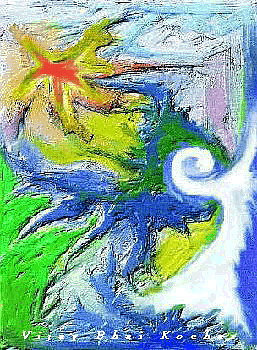
Abb.: "Rahu Ketu" / Gemälde von Vijay Bhai Kochar, Indien
[Bildquelle.
http://www.ehcc.org/archives/mai022003.htm. -- Zugriff am 2004-02-15]
Râhu und Ketu sind "unsichtbare Wandelsterne (Planeten)", sie sind für Sonnen- und Mondfinsternisse zuständig. Astronomisch entsprechen sie den "Mondknoten", d.h. den Punkten an denen die Mondbahn die Ebene der Erdbahn um die Sonne (Ekkliptik) schneidet. Da sich diese Schnittpunkte periodisch verändern, gehören Râhu und Ketu zu den Wandelsternen.
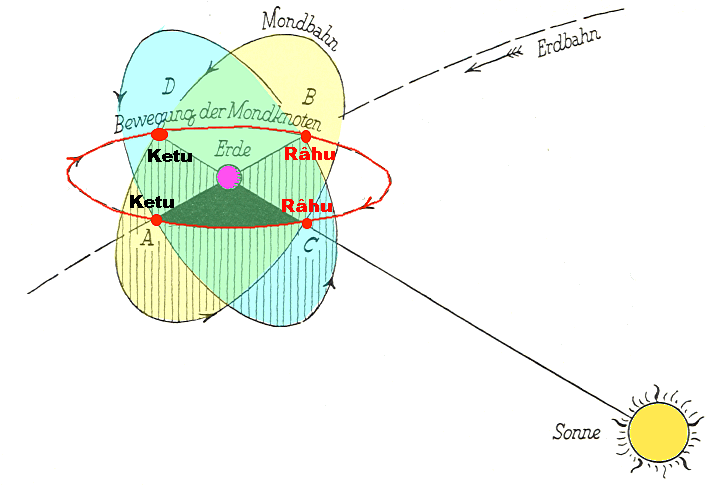
Abb.: "Diagramm zur Veranschaulichung der langsamen, rückläufigen Bewegung der
Mondknoten."
"Es werden zwei Mondbahnstellungen gezeigt, AB und GD, die letztere Stellung folgt 4 bis 5 Jahre nach der ersten. Finsternisse finden statt, wenn der Knoten C (Sonnenfinsternis) oder D (Mondfinsternis), in welchem die Mondbahn die Ebene der Erdbahn schneidet, mit der Erde und der Sonne auf einer Geraden liegt, vorausgesetzt natürlich, daß der Mond im Knoten steht. (Die Neigung der Mondbahn in bezug auf die Ekliptik ist hier stark übertrieben.)"
[Bildquelle: Hogben, Lancelot Thomas <1895 - 1975>: Mensch und Wissenschaft : Die Entstehung und Entwicklung der Naturwissenschaft aus den sozialen Bedürfnissen. Ein Buch zur Weiterbildung. -- Zürich : Artemis. -- 2 Bde. -- Originaltitel: Science for the citizen (1938). -- Bd. 1. -- 1948. -- S. 72.]
Ein Mondknoten durchlauft in 18,6 Jahren einmal die ganze Ekliptik.
Da für eine Mondfinsternis bzw. Sonnenfinsternis Mond, Erde und Sonne in einer Geraden liegen müssen, muss der Mond bei diesen Ereignissen sich auf bzw. in unmittelbarer Nähe eines Mondknotens befinden. Diese Beobachtung erklärte man im alten Indien dadurch, dass man annahm, dass himmlische Dämonen an diesen Stellen den Mond bzw. die Sonne verschlingen. Den Erdschatten bzw. den Mondschatten bei Mond- bzw. Sonnenfinsternis deutete man damit, dass diese Dämonen (Râhu, Ketu) nur bei solchen Finsternissen sichtbar würden, sonst aber unsichtbar am Himmel sind. (siehe unten):
Mahâbhârata I.17.5ff.:
"While the Gods were drinking the yearned-for Elixir, a Dânava by the name of Râhu took the guise of a God and began to drink it too. The Elixir had gone down as far as the Dânava's throat when the Sun and the Moon gave alarm as a kindness to the Gods. The blessed Lord who wields the discus thereupon cut off his diademed head as he started to drink. The Dânava's gigantic head fell rolling on the ground and roared most frighteningly. Ever since there has been a lasting feud between Râhu's head and the Sun and the Moon; and even today he swallows them both." [Quelle: The Mahabharata / translated and ed. by J. A. B. van Buitenen. -- Chicago : Univ. of Chicago Pr. -- Band 1: The book of the beginning. -- 1973. -- XLIV, 492 S. -- ISBN 0-226-84648-2. -- S. 75.]
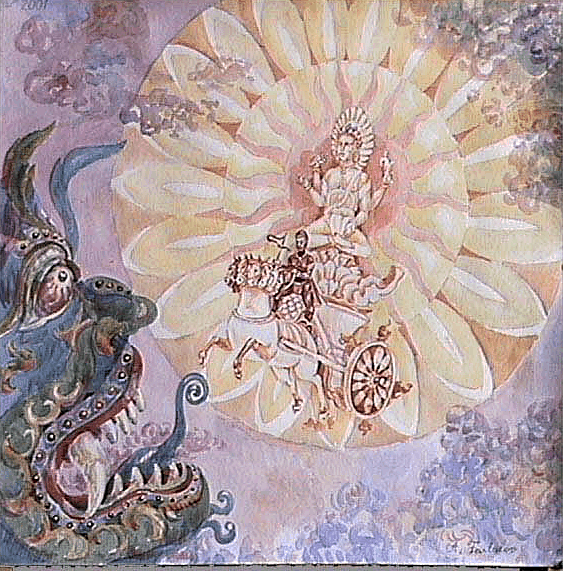
Abb.: Sûrya und Rahu / Aquarell von Alex Fantalov, 2003 [Bildquelle: http://fantalov.tripod.com/Indian3.htm. -- Zugriff am 2004-02-14]
[Sehr empfehlenswert ist ein Besuch bei den - vor allem mythologischen - Aquarellen von Alex Fantalov: http://fantalov.tripod.com/. -- Zugriff am 2004-02-14
"RÂHU. Râhu and Ketu are in astronomy the ascending and descending nodes. Râhu is the cause of eclipses, and the term is used to designate the eclipse itself. He is also considered as one of the planets, as king of meteors, and as guardian of the south-west quarter. Mythologially Râhu is a Daitya who is supposed to seize the sun and moon and swallow them, thua obscuring their rays and causing eclipses. He was son of Vipracitti and Sinhikâ, and is called by his metronymic Sainhikeya. He had four arms, and his lower part ended in a tail. He was a great mischief-maker, and when the gods had produced the Amrta by churning the ocean, he assumed a disguise, and insinuating himself amongst them, drank some of it. The sun and moon detected him and informed Vishnu, who cut off his head and two of his arms, but, as he had secured immortality,
his body was placed in the stellar sphere, the upper parts, represented by a dragon's head, being the ascending node, and the lower parts, represented by a dragon's tail, being Ketu the descending node. Râhu wreaks his vengeance on the sun and moon by occasionally swallowing them.The Vishnu Purâna says, "Eight black horses draw the dusky chariot of Râhu, and once harnessed are attached to it for ever. On the Parvans (nodes, or lunar and solar eclipses) Râhu directs his course from the sun to the moon, and back again from the moon to the sun. The eight horses of the chariot of Ketu, swift as the wind, are of the dusky red colour of lac, or of the smoke of burning straw."
Râhu is called Abhra-pisâca, ' the demon of the sky;' Bharanî-bhû, 'born from the asterism Bharnîi;' Graha, 'the seizer;' Kabandha, 'the headless.'"
[Quelle: Dowson, John <1820-1881>: A classical dictionary of Hindu mythology and religion, geography, history, and literature. -- London, Trübner, 1879. -- s.v. ]
"KETU. The descending node in astronomy, represented by a dragon's tail; also a comet or meteor, and the ninth of the planets. He is said to be a Dânava, and son of Vipracitti and Sinhikâ. He is also called A-kacha, ' hairless;' Asheshâ-bhava, 'cut off;' Munda, ' bald.' See Râhu." [Quelle: Dowson, John <1820-1881>: A classical dictionary of Hindu mythology and religion, geography, history, and literature. -- London, Trübner, 1879. -- s.v. ]
Varâhamihira (gestorben 587 n. Chr.), indischer Mathematiker, Astronom, Astrologe usw.
1. Though the demon's head was cut off, it was not deprived of life as a result of his having tasted nectar, and, it is said, it assumed the form of a planet.
2. They say that the Dragon's Head (Râhu) being similar in form to the orbs of the luminaries and dark in colour, is not visible in the sky except on the Parvan days (i.e. New and Full Moon). As a result of the Creator's boon Râhu is visible only during eclipses and not on other days.
[The Purânic story runs thus : Simhikâ, one of the wives of Sage Kashyapa, requested her husband for progeny at an unseasonal hour. Enraged at this untimely request, he gave her a son who was dreadful like the God of Death. This child came to be called Râhu. Soon after his birth he fought with Aditi's son and was trounced. Humiliated by this, he performed severe penance for ten thousand divine years on a Himalayan peak. He asked Brahman, when the latter appeared before him, to confer on him the status of a planet, immortality, victory over the Gods and power to devour the two luminaries. At this, the Lord spoke smilingly thus : "You will find it extremely hard to digest these two; still, be it so." So saying, Brahman vanished. Then Râhu rushed at the luminaries. But Lord Visnu hurled his discus, cut off his head and said, "Let the Creator's words not go to waste. In your respective periods you may devour the two luminaries and thereby indicate good and bad things for the world."]
3. Some Sages declare that Râhu i.e. son of Simhikâ, is of a serpentine form with only the face and tail, while others hold that he is formless and of the nature of pure darkness.
4. In case Râhu has a body, moves in the zodiac, possesses only the head and a circular shape, how is it that he seizes the luminaries who are separated from him by 180°, when his own movement is fixed and uniform?
5. If, on the other hand, his motion is not fixed, how is it that his exact position is determined by calculation? If he is to be identified only by his tail and face, why should he not seize them (the luminaries) at other intervals (instead of only when 180° apart)?
6. If this Râhu who is a big serpent in appearance actually seizes the Sun or the Moon with his tail or mouth, why should he not obstruct half of the zodiac that lies between his head and tail?
7. If there should be two Râhus, when the Moon is eclipsed by one Râhu when she is rising or setting, the Sun who is 180° away from the Moon should also be eclipsed by the other Râhu whose rate of motion is also equal (to that of the other Râhu).
8. At a lunar eclipse the Moon enters the shadow of the earth, and at a solar eclipse she enters the Sun's disc. That is the reason why the lunar eclipse does not begin at the western limb, nor the solar one at the eastern limb.
9. Just as the shadow of a tree goes on increasing on one side as a result of the Sun's movement, even so is the case with the shadow of the earth every night by its hiding the Sun during its rotation.
10. In her course towards the east, if the Moon tenanting the 7th house from the Sun, does not swerve much either to the north or the south (when her declination is very little), she enters the earth's shadow.
11. The Moon situated below and moving from the west obstructs the solar disc like a cloud. The solar eclipse, therefore, is different in different countries according to the visibility of the eclipsed disc.
12. When the lunar eclipse takes place, the obstructing agency is very large, whereas in the solar eclipse it is small. Hence in semi-lunar and semi-solar eclipses the luminous horns become blunt and sharp respectively.
13. In this manner have the ancient seers endowed with divine insight explained
the causes of eclipses. Hence the scientific fact is that Râhu is not at all the
cause of eclipses.
[The above categorical statement of our author shows that though he has regard for religious traditions, he would not allow scientific truths to be diluted with popular beliefs.]
14. -15.A boon was conferred on the demon Râhu by the Creator : "Thou shalt sustain thyself by means of the oblations offered to the sacred Fire at an eclipse." Hence Râhu's presence is assumed at that time. The Moon has two nodes, Northern and Southern, as a result of her declination (deviation to the north or south), which can be ascertained by astronomical calculations. The Ascending Node is called Râhu.
[Here the author refers to the traditional aspect of Râhu mentioned in the Purânas. The two nodes of the Moon are called Râhu and Ketu respectively.]
16. An eclipse can by no means be ascertained through omens and other indications. For, portents such as fall of meteors and earth tremors occur at other times as well.
[This refers to a popular belief that an eclipse is heralded by some unusual occurrences such as earthquake and terrific thunder.]
17. Scholars should not believe the following traditional statement to the effect that an eclipse cannot take place except, when there is a combination of five planets in the same zodiacal Sign, and that a week before the eclipse i.e. on the previous 8th lunar day, its characteristics can be inferred from the behaviour or appearance of a drop of oil poured on the surface of water.
[Here two more popular beliefs are mentioned.]
18. The magnitude of the solar eclipse should be determined through the Moon's deflection i.e. parallax. The direction of commencement of the eclipse is found out through the deflection and angles of the Moon known as Ayanavalana and Akshavalana. The duration of the eclipse is got by noting the exact time of conjunction of the Sun and the Moon. All these have been explained in detail by me in my astronomical work Pancasiddhântikâ.
19.
are in order lords of the successive half-yearly periods since creation.
20.-23.
[Übersetzung: Varahamihira's Brhat samhita = Brhatsamhita : with English translation, exhaustive notes and literary comments / M. Ramakrishna Bhat. -- Delhi : Motilal Banarsidass. -- 2 vol. -- Vol. 1. -- 1981. -- ISBN 81-208-0098-2. -- S. 42-47.]